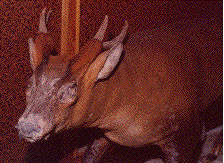|
|
Post by Peter on Apr 15, 2005 14:32:55 GMT
Giant muntjac:
Also called the Mang Lon muntjac, this species was described in 1996 as Megamuntiacus vuquangensis. Rob Timmins and Tom Evans, two British ornithologists, began the search for this animal by noticing that some muntjac horns displayed in Laotian homes in the Nakai Nam Theun reserve (adjacent to the Vu Quang reserve across the border in Vietnam) were unusually large. Laotian hunters described the animal these horns came from as a unique type of muntjac, larger than the red muntjac they hunted most often. The expedition members collected skulls and antlers of the unusual deer, then happened across a live specimen in a the now-famous menagerie in Lak Xao. MacKinnon had also collected a skull of this animal across the border in Vu Quang. It was he who first called it the "giant muntjac." George Schaller and Elisabeth Verba wrote the formal description. Its status in a separate genus is not universally accepted, but all agree it's a very distinct species.
|
|
|
|
Post by Melanie on Jun 12, 2005 14:14:32 GMT
The giant muntjac (Megamuntiacus vuquangensis) was discovered in 1994 in evergreen forests of the Annamite Mountains that border Laos (Lao People's Democratic Republic) and Vietnam. We describe its known distribution in Laos and provide the first detailed description of the species. Comparison of its skull and antlers with those of sympatric red muntjacs (Muntiacus muntjak) and other muntjacs support its designation as a distinct species. Morphological and genomic DNA data suggest that the giant muntjac belongs with other muntjacs in the genus Muntiacus and not in a genus of its own.
|
|
|
|
Post by Melanie on Jun 12, 2005 14:16:18 GMT
|
|
|
|
Post by another specialist on Feb 17, 2007 18:38:36 GMT
Giant Muntjack - A survey in 1994 carried out jointly by the Ministry of Forestry, Forest Inventory and Planning Institute of Vietnam and World Wide Fund for Nature team in Vu Quang, Ha Tinh province, following the discovery of new species of sao la, has revealed a second new ruminant species - a medium-sized deer. The new deer is most closely related to the common muntjac (Muntiacus muntjac) with which it is sympatric but differs significantly from known muntjac species in several characteristics. In Vietnam, skulls with horns of this species have been found in many forest areas along the Truong Son Mountain range. The giant muntjac was found concurrently in central Lao PDR. The giant muntjac has a wider distribution than the saola, which is also restricted to the Truong Son Mountains. Hunting with snares has apparently reduced the leaf muntjac's numbers over the last decade, even though it is not considered a particularly valuable species because of its small size and antlers. Vu Quang Project 1995-2000: Together with the saola, the habitat of the giant muntjac is protected by strengthening the management of the Vu Quang Nature Reserve and by supporting the livelihoods of local people. A survey in Nghe An and Ha Tinh province carried out in 1993-1994 provides baseline data for future conservation. The transboundary project (1995-1999) was designed to foster the cooperation between Vietnam, Lao PDR, Cambodia to conserve the forest of Truong Son mountain range. www.molyworld.net/aa/muntjacks.htm |
|
|
|
Post by another specialist on Feb 17, 2007 18:39:15 GMT
|
|
|
|
Post by another specialist on Feb 18, 2007 9:37:11 GMT
Megamuntiacus vuquangensis This robust muntjak deer was discovered in Vu Quang forest reserve, in Ha Tinh province. Specimens have been found in Nghe An province, and in Dak Lac province. This suggests that Megamuntiacus vuquangensis also has a wider much distribution than is known. See also Schaller and Verba (1996) for recent analysis of material from Laos.  Mang Lon: Megamuntiacus vuquangensis This specimen shows the robustness of this deer, which is about the size of a large dog. The antlers have shorter, thicker pedicel or base and longer tines than the common Muntiacus muntjac. Credit: Forest Inventory and Planning Institute and V. Weitzel coombs.anu.edu.au/~vern/species.html |
|
|
|
Post by surroundx on Dec 11, 2015 15:14:43 GMT
|
|
|
|
Post by surroundx on May 24, 2016 8:55:46 GMT
This species is probably synonymous with the Late Pleistocene/early Holocene M. gigas. Hence, since the latter description was published first this species has in effect been rediscovered. Source: Turvey, Samuel T. et al. (2016). Holocene range collapse of giant muntjacs and pseudo-endemism in the Annamite large mammal fauna. Journal of Biogeography. DOI: 10.1111/jbi.12763 [ Abstract] |
|
|
|
Post by Melanie on May 31, 2018 13:24:37 GMT
|
|
|
|
Post by surroundx on Jul 7, 2018 7:24:07 GMT
|
|
|
|
Post by koeiyabe on Jan 3, 2019 0:12:57 GMT
|
|
|
|
Post by surroundx on Mar 16, 2019 5:59:59 GMT
Stimpson, C. M., Utting, B., O’Donnell, S., Huong, N. T. M., Kahlert, T., Manh, B. V.,Khanh, P. S. and Rabett, R. J. (2019). An 11 000-year-old giant muntjac subfossil from Northern Vietnam: implications for past and present populations. R. Soc. open sci. 6: 181461. |
|
|
|
Post by surroundx on Apr 25, 2022 11:50:59 GMT
|
|